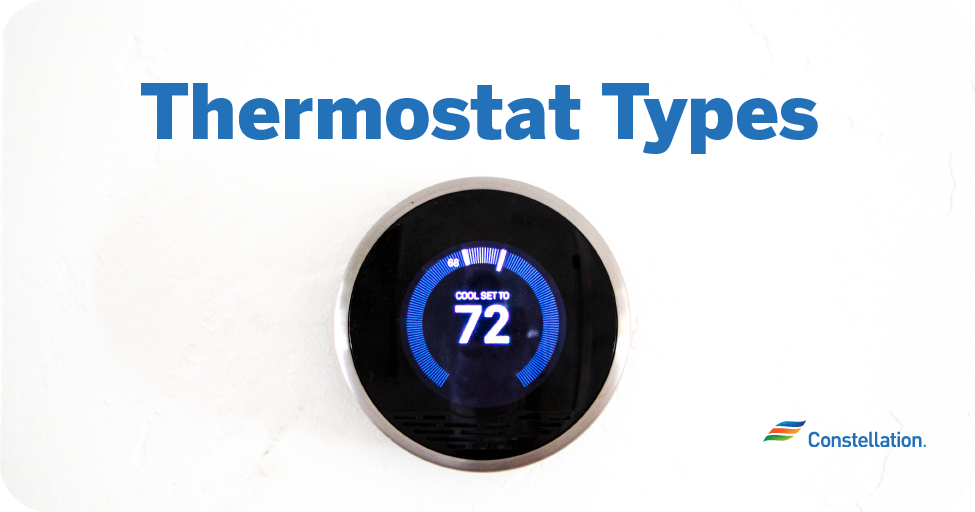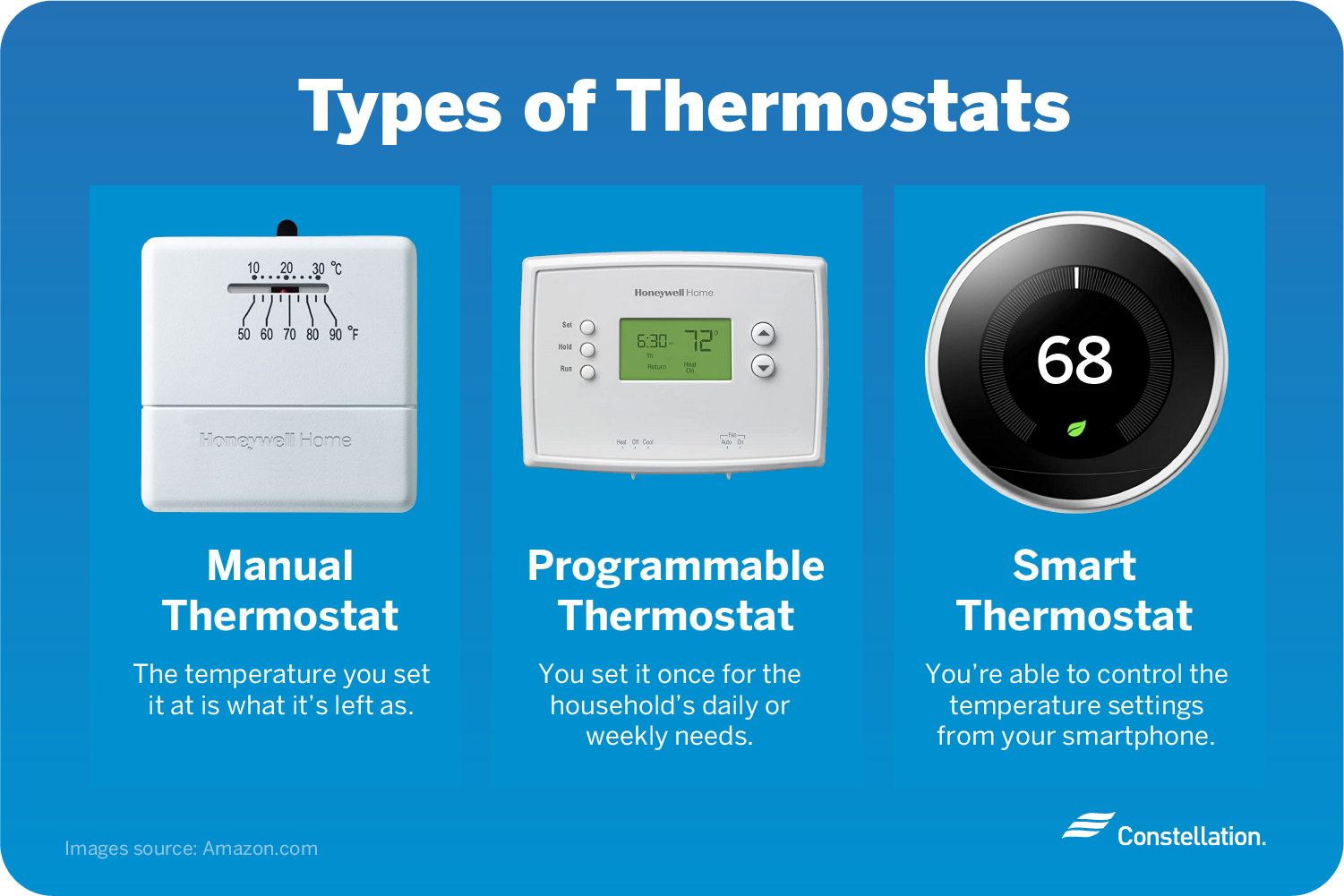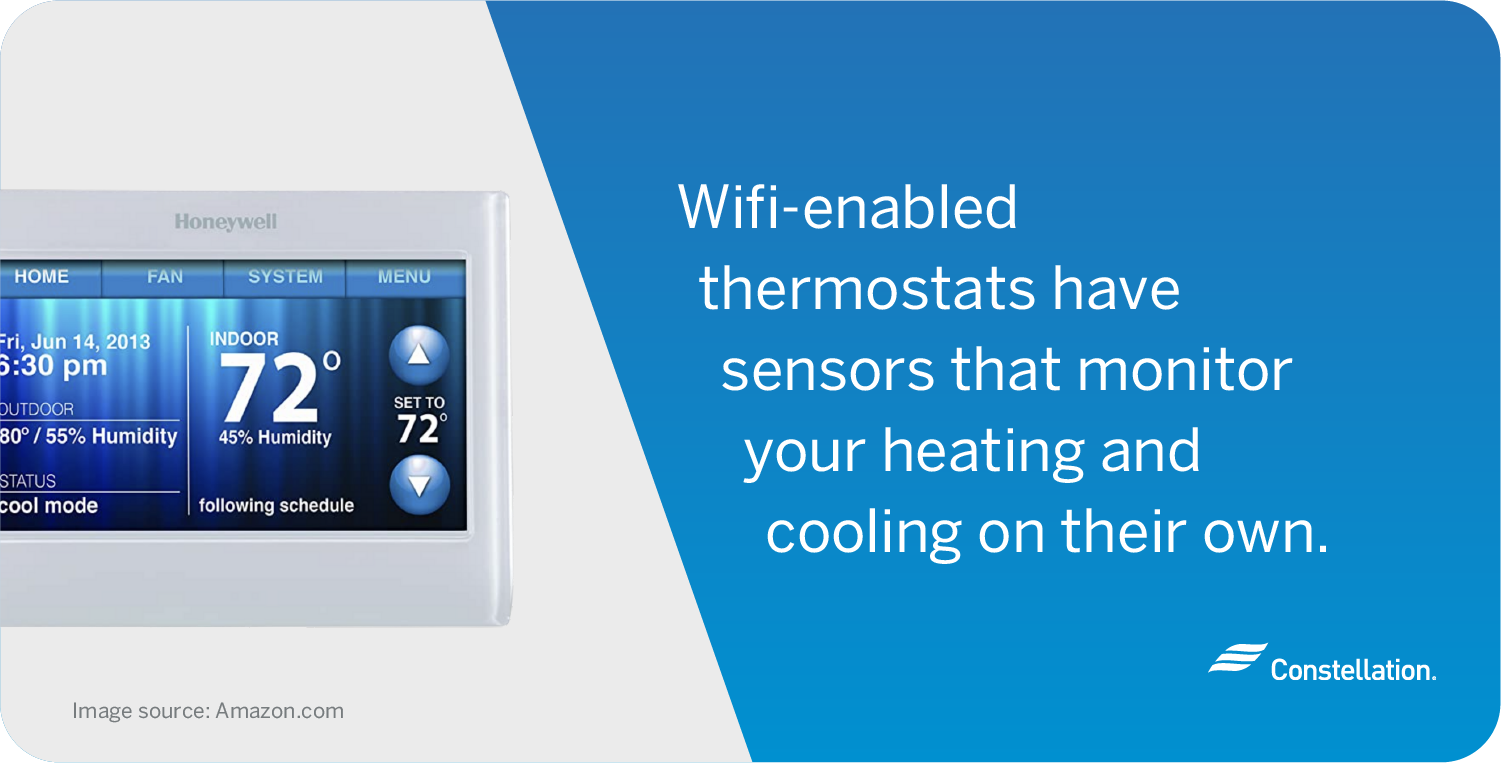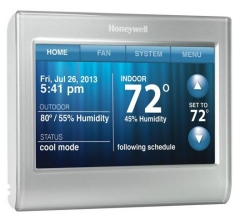
- Category:
Energy Efficiency -
Last updated:
April 16, 2025
Thermostat Types Explained
Thermostats control the temperature in your house. But is it really that simple? If your thermostat breaks and you find yourself looking for a new one, you’ll probably learn quickly that there isn’t just one run-of-the-mill type of home thermostat. There are many thermostat options— and cool options at that!
So how are you to know which is the best type of thermostat to suit your needs? To help you navigate the different thermostat types, we’ve listed the three most common types of thermostats and their features, from least to most technologically advanced.

1. Manual Thermostats
Manual thermostats allow you to change the current temperature from each wall unit in your house— there are usually one or two in a home. It’s typically not complicated, and the temperature you set it at is the temperature your house stays. No hassle, no change.
Benefits of Manual Thermostats
To some more technologically savvy folks, manual thermostats may seem like they’re outdated, but many households still use manual thermostats. Here are some benefits of using manual thermostats:
- Lots of options available. They are the most commonly used type of thermostat in homes.
- User friendly. Manual thermostats are inherently user friendly and are easy to maneuver for those who aren’t very tech-savvy.

Image Source: shopconstellation.energyearth.com
LUX Manual Thermostat – This LUX thermostat is easy to program and easy to use. If you need just one schedule during the weekdays and a different schedule for the weekend, this thermostat option is ideal.

Image Source: shopconstellation.energyearth.com
Honeywell Aube Manual Thermostat – This compact, non-programmable thermostat is the perfect replacement for your old mechanical thermostat. This model is ideal for tight spaces.
If you haven’t put a lot of thought into how different thermostats can control the temperature in your home, but want to, continue reading to compare the benefits of a smart thermostat or programmable thermostat.
Drawbacks of Manual Thermostats
Manual thermostats can be a source of frustration when it comes to heating your home. It may seem like you’re saving money by not upgrading to a newer model (whether that’s a smart thermostat or WiFi-enabled). But there are some drawbacks to manual thermostats you may want to consider.
- Most cannot be programmed. Most manual thermostats only allow one temperature setting and cannot be specially pre-programmed to adjust based on time or day of the week.
- Fewer options for control and customization. As the name suggests, you must always change the temperature manually, so there are fewer options for customization.
- No efficiency features. Manual thermostats don’t keep track of how you heat and cool your house and suggest efficiency improvements the way some smart thermostats can.
2. Programmable Thermostats
Want to make a change that may quickly lower your home heating and cooling costs? Consider installing a programmable type of thermostat. Before we look at the programmable thermostat savings, it’s important to understand the different types. Consumer Reports describes the benefits of programmable thermostat varieties this way:

- 7-day models offer the most flexibility by allowing homeowners to set different programs (usually with four different temperature periods per day) for each day of the week.
- 5+2 models allow homeowners to have one set schedule for Monday-Friday and one schedule for weekends.
- 5-1-1 models are good for homeowners who want to set one temperature schedule for Monday-Friday and then a different schedule for each day of the weekend.
Benefits of Programmable Thermostats
The potential benefits of programmable thermostats depend upon lifestyle to some extent, but here are some ways programmable thermostats present possible savings opportunities:
- Allows you to pre-set a schedule. Instead of having to manually change settings multiple times a day, a homeowner can set the automated thermostat once for the household’s daily or weekly needs.
- Helps eliminate guesswork. No more worrying about remembering to turn down the heat or air conditioning before you walk out the door. And, if you’ve opted for a smart vs. programmable thermostat, you can always make changes from afar by overriding the set temperature plan.
- Offers multi-zone climate control. A programmable thermostat can offer as many as eight different climate control zones. This means that you can heat or cool specific rooms whenever you want to, as well as choose individual temperature settings.
 Image Source: shopconstellation.energyearth.com
Image Source: shopconstellation.energyearth.com
Honeywell 5-1-1 Day Programmable Thermostat – Honeywell’s 5-1-1 Day Programmable Thermostat is a very easy-to-use programmable thermostat with intuitive logic that responds to your choices and schedule for optimal comfort and energy savings.
 Image Source: shopconstellation.energyearth.com
Image Source: shopconstellation.energyearth.com
Honeywell 7-Day Programmable Thermostat – Its Smart Response Technology continually adjusts the pre-heating/cooling of your home, so you are comfortable at your programmed times.
If you’re looking to achieve maximum programmable thermostat savings, you might want to consider investing in programmable communicating thermostats (aka “smart” thermostats) that are connected to a home’s Wi-Fi.
Drawbacks of Programmable Thermostats
If you’re looking for more flexibility when it comes to changing the temperature of your home, a programmable thermostat could be a good option. Although it has advancements compared to a manual thermostat, there are some disadvantages to programmable thermostats to keep in mind.
- More expensive than non-programmable alternatives. The average cost of a programmable thermostat is $100 to $200, not including installation.
- Installation can be difficult. Compared to manual thermostats, installing a programmable thermostat yourself may cause frustration.
- May have compatibility issues. It’s important to keep in mind what type of programmable thermostat is compatible with your HVAC
3. Smart Thermostats and Wi-Fi-Enabled Thermostats
You have probably heard about smartwatches and smartphones, but now “smart” devices are entering your home, too. They are electronics that connect, either to each other through a home hub like Constellation Connect, or to separate devices that have software and networks that allow these items to function by communicating with other devices rather than directly with humans.
When you install a smart thermostat, you’re able to control the temperature settings from your smartphone or other connected device. But the technology doesn’t end there. You have a choice between a smart thermostat vs. Wi-Fi-enabled thermostat. A wireless — or Wi-Fi — thermostat provides a more effective way to manage the way you heat and cool your home. With the ability to connect to your devices via Wi-Fi, you have the option to control your home temperature even while you’re away.

Benefits of a Smart Thermostat
The primary benefit of a smart thermostat is in making your life easier and your home more energy efficient. A smart thermostat’s energy efficiency is effective because it takes the guesswork out of programming an automated thermostat or having to manually adjust the temperature daily. Other benefits of smart thermostats are:
- Easy to program. When you set up your smart thermostat, you can program it so that it will adjust the temperature before you arrive home daily, once you’ve gone to bed, when you wake up, and so on.
- Energy efficient. If you use a smart thermostat, energy efficiency can happen even if you are on the go, travel frequently, or live in an extreme climate.
- Can be controlled from anywhere. You don’t have to worry about your house being too warm or too cold during the hours you’re at work. You can set it to the optimal temperature for saving money on energy costs, but still be perfectly comfortable when you arrive home.
- Provides data on your energy usage. Smart thermostats can provide you with information about how you use energy and how you could potentially use less. Some models connect to apps that offer data that indicates your usage per month, how many units of energy are being spent on heating or air conditioning, and how your month compares against prior time periods.

Benefits of a Wi-Fi-Enabled Thermostat
All smart thermostats need to be Wi-Fi-enabled in order to communicate with your mobile devices. As a result, Wi-Fi-enabled thermostats offer a similar set of benefits, despite lacking the more advanced features. Some advantages of Wi-Fi-enabled thermostats include:
- Relays information in real time. Wi-Fi-enabled thermostats have sensors, so the partner app on your phone can let you know if your house gets too hot or too cold. If you live in a hot, humid place like Texas, this could be extremely helpful.
- Manage your home’s temperature remotely. A Wi-Fi-enabled thermostat can ping your connected device if the temperature dips below a temperature you specify, preventing frozen pipes in a cold snap. And you can either control the thermostat from your device or manage the settings so that it happens without your intervention.
- Detects outdoor temperatures. Some Wi-Fi-enabled thermostat models are connected to outdoor sensors, so they can detect the temperature and humidity of the outdoor climate. This can be a good indicator as to how to set temperature indoors, especially when you’re away from home.
Drawbacks of Smart Thermostats and Wi-Fi-Enabled Thermostats
It may seem like an upgrade to smart thermostats or Wi-Fi-enabled thermostats is the logical choice. They can provide better efficiency, ease of access, and more customization, but are smart thermostats worth it? Unfortunately, there are some drawbacks when it comes to these types of thermostats.
- Most cannot be programmed. Most manual thermostats only allow one temperature setting and cannot be specially pre-programmed to adjust based on time or day of the week.
- Fewer options for control and customization. As the name suggests, you must always change the temperature manually, so there are fewer options for customization.
- No efficiency features. Manual thermostats don’t keep track of how you heat and cool your house and suggest efficiency improvements the way some smart thermostats can.
How to Choose from Different Types of Smart Thermostats
So, you’ve decided to start looking for a smart thermostat: Now what? Like with any electronic device, you might have certain features in mind as you search for the best smart thermostat. Whether you’re debating between a smart vs. Wi-Fi-enabled thermostat, or you’re looking for the best smart thermostat for multiple zones, consider how each type of thermostat fits into your lifestyle and energy needs.

Image Source: nest.com
Nest Learning Thermostat: This smart thermostat is called a “learning” thermostat because it tracks your manual or remote temperature adjustments in order to “learn” your habits and preferences over time. And there’s another perk; if your temperature gets to a certain number of degrees, a green leaf will appear on the display to let you know that you’re in a smart thermostat energy-efficiency state.

Image Source: shopconstellation.energyearth.com
Honeywell Wi-Fi Smart Thermostat: Honeywell’s reliable and highly-rated app allows you to program your thermostat from your computer, tablet, and smartphone, whether you’re across the room or around the world. It offers flexible programming options for business and residential needs and also learns your heating and cooling cycle times to deliver just the right temperature.

Image Source: shopconstellation.energyearth.com
ecobee4: The ecobee line of smart thermostats works with room sensors to maintain your desired environment. Using the sensors, the ecobee detects where you need warm or cool air based on motion detection, humidity, and other factors. This ecobee thermostat can connect with Alexa voice assistance and Apple Homekit.
As is the case with any technology, even the best smart thermostats are going to evolve rapidly. With any electronics, it’s important to compare features before purchasing so that you are buying the model or style that will be most compatible with your needs.
Best thermostat for multiple zones
If you’re looking for the best thermostat for multiple zones, then that can add another set of challenges. “Multiple zones” means that you might have more than one unit that controls the HVAC in your home. For example, the needs might be different for separate areas of the house — your upstairs might get significantly warmer than your downstairs because of heat from the roof, window exposure, lack of shade, or due to other factors. Currently, ecobee and eversense models support multiple zones, but that could change as other brands update their smart thermostats over time.
Everyone wants to live comfortably in their homes. The type of thermostat you choose can determine how comfortable your home is throughout the changing seasons. All of this leads to the question: Which type of thermostat is best for you? With so many different types of thermostats on the market today, it can be difficult to choose.
Among the many pros and cons of manual, programmable and smart/Wi-Fi-enabled thermostats, it all comes down to which type fits your budget and lifestyle. For some, their house can be hot upstairs and cold downstairs. The right type of thermostat can help you go from cold and uncomfortable to warm and happy. Find out other ways to improve your home’s heating and cooling efficiency with Constellation.




